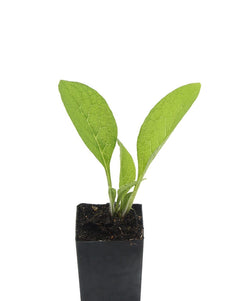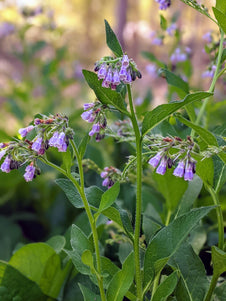

















Comfrey
Comfrey

- In stock, ready to ship
- Inventory on the way

Usually available: All year
Life cycle: Herbaceous Perennial
Height: 60 - 90cm
Position: Sun / part shade
Soil preference: Moist / well drained
This is how we pack and send your Herb Plants to all states except TAS & WA
You will receive
- 1 Comfrey Herb Plant in a 50 X 75mm tube - General growing instructions
All of our Herb Plants are grown organically with certified organic potting mixes and fertilizers
Botanical Name: Symphytum x uplandicum
Comfrey is a perennial herb native to Europe and can be found growing in damp places along riverbanks and in ditches. It has large, hairy leaves and grows in a rosette to 1 m in height. The small bell-shaped, mauve or pink flowers are borne in clusters. The roots are large with black/brown skin and fleshy insides, and travel deep into the soil.
The older leaves of comfrey can be steamed or battered and fried.
A poultice of the leaves and or root, or a comfrey ointment, can be used to heal wounds, burns, bruises, ulcers, dry irritated skin conditions and will help prevent scars. Caution when using comfrey on deep wounds as comfrey knits the skin too fast and could trap an infection within the wound.
Dried comfrey leaves and roots are commonly used externally for any kind of inflammatory swelling and reduce inflammation associated with sprains and broken bones.
Use the leaves in the compost heap, as rich mulch, place leaves under roses and fruit trees. Comfrey makes a good liquid fertilizer - half fill a large bucket with crushed comfrey leaves. Fill bucket with water and cover securely. Stand in the shade for 4 weeks. Stir occasionally. Dilute 1 part with 4 parts water. Use a watering can to fertilise plants every 3-4 weeks. (This smells really bad).
Growing Conditions
Comfrey is tough plant when grown in the right spot, it grows easily from small root pieces, choose your position carefully as it is hard to get rid of. It will grow in semi-sun or in full sun providing it gets enough water during summer. Although comfrey likes plenty of water it does not like to be in a boggy position. During summer comfrey produces masses of large leaves. During winter our garden is quite cold and the leaf growth slows to a few small leaves.
All information provided on this website is for informational purposes only. Please seek professional advice before commencing any treatment.





